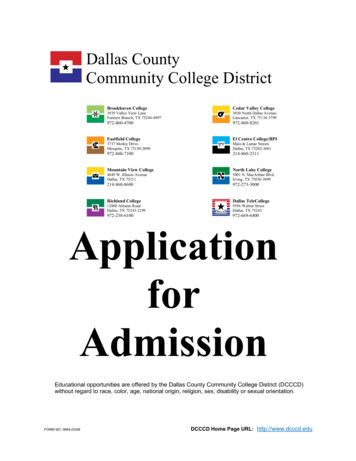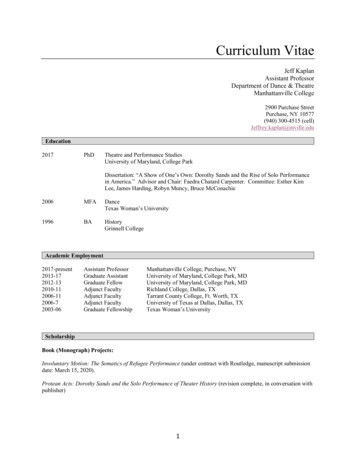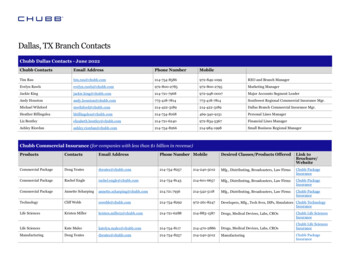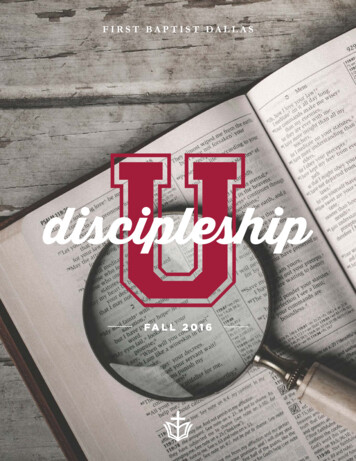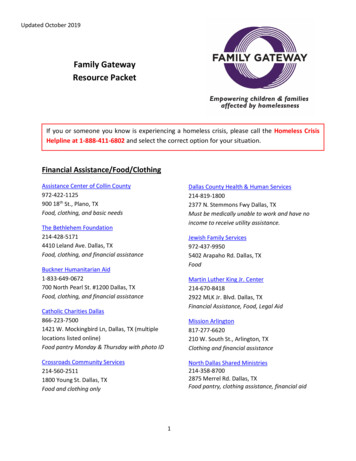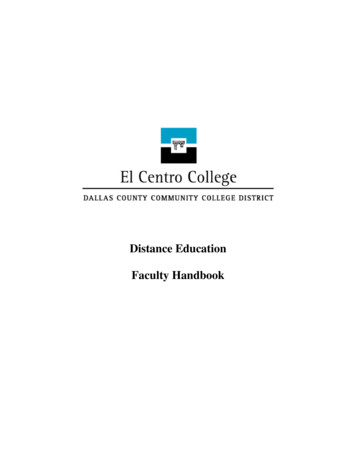
Transcription
Distance EducationFaculty Handbook
Table of ContentsDistance Education at El Centro College.1Online Courses .1Video-Based .1Online Partial .1Online/Classroom (also known as Hybrid) . 1The Virtual College of Texas (VCT) .1Distance Education Mission Statement .2What is the Difference in eCampus, BlackBoard and eConnect?. .3What If I Want to Teach an Online Class? . 4-8Qualifications to Teach Online . 4-5Instructor Certification .5When Should I Take the Training Classes? .5Assessment Guidelines . 5-6Training Courses . 6-8Minimum Expectations for Online Faculty . 9-11Software Resources . 12-15Online Resources . 16-17Other Free Useful Software . 18-19Other Resources . 20-22Advising Potential Online Students . 23-25SmarterMeasure .23Basic Computer Skills.23Technical Requirements. 23-24Useful Software .24eMail Accounts .25Steps to Enrollment . 25-26DART Free to El Centro .26Virtual Office Hours for Distance Education Faculty .27Telecommuting Policy for Online Instructors at El Centro College. 28-30Online Instructional Visitation Appraisal . 31-32Start Here Quick Reference . 33-34Support Services for El Centro College Students . 35-38Getting a Course Online Process . 39-40Course Certification Guide . 41-42Principles of Good Practice for Courses Offered Electronically (from the THECB). 43-44Online Course Approval Form. 45-47Instructions for Scoring the Online Course Selection Rubric.48Online Course Scoring Rubric . 49-50El Centro College Online Course Peer Review Process . 51-52Peer Review Team Qualifications .53ECC Distance Learning Mentor Program . 54-56Online Course Peer Review Confidentially Form .56
Table of Contents (Continued)El Centro Online Course Planning Grid .57Quality Matters Rubric Standards 2014-2016 .58El Centro Online Course Design and Standards Checklist . 59-64Online Course Peer Review – Instructor Worksheet . 65-70Quality Matters Self-Check . 71-73Quality Matters Standards and Annotation . 74-103Standard #1 (Course Overview & Introduction) . 74-78Standard #2 (Learning Objectives) . 78-83Standard #3 (Assessment & Measurement) . 83-87Standard #4 (Instructional Materials) . 87-91Standard #5 (Course Activities & Learner Interaction) . 91-94Standard #6 (Course Technology) . 94-97Standard #7 (Learner Support). 98-100Standard #8 (Accessibility & Usability) . 100-103DCCCD Quality Matters Standard 8 Accessibility Checklist . 104-105Accessibility Checklist. 106-115
Distance Education at El Centro CollegeIn 1972, El Centro College offered its first Telecourse. It was a Government course written and taughtby Jim Hankerson who was an El Centro full time faculty member of the Social Sciences Division. Ithad a good enrollment of 450 students the first semester taught. Although Telecourses have been partof El Centro’s curriculum for a number of years, the first online course was offered at El Centro in2000. Distance learning courses provide instruction to students who are not in the same location asthe instructor. Various forms of technology are used including the Internet, television, videotape,computer CDs, print media and the telephone. Admission in a distance learning course has the sameprerequisite requirements and provides the same credit as a comparable on campus section.How Are Distance Learning Courses Delivered?Several methods of delivery of distance courses are used at El Centro College:Online Courses (formerly called INET)Online courses are delivered using computers and online media. These courses use eCampus andmay also include CD’s and audio/video streaming video or publisher’s video cartridge. No oncampus testing or activities are required; however, off-campus proctored exams may be required.Refer to the course annotations, found under the course listing, or contact the instructor for moreinformation.Video-Based (formerly called Telecourses)Content delivered through a local cable channel, CD, DVD, MP4 system, or VHS cassette. Oncampus testing or activities may be required. Content is not delivered through computer Internetactivities, but instructor may provide some communications, syllabus, orientation, and testreview by email.Online Partial (formerly called Telecourse PLUS)Most of the content is delivered through computers or multimedia. These courses use eCampusand may include CD’s and audio/stream video. On-campus testing, orientation, and/or otheractivities may be required. Students are required to have Internet access and a required browser.Online/Classroom (also known as Hybrid)1% to 49% of the content is offered online and 50% or more is delivered through activities oncampus. These courses use components of computer instruction, multimedia activities, andclassroom time. On-campus classroom time is required. On-campus classroom time isrequired.The Virtual College of Texas (VCT)The Virtual College of Texas, a statewide consortium, offered more than 200 courses to studentsof VCT member colleges. These courses may originate from any of the 50 public college systemsin the state but have the same tuition and fees, admission procedures and requirements. Theyappear on students’ transcripts as courses of ECC. Pam Quinn, Provost of the R. Jan LeCroyCenter for Educational Telecommunications, was one of the original creation team that wasappointed by the Coordinating Board to come up with the concept of the Virtual College ofTexas. It has been active since courses were first offered in the Fall of 1999.1
El Centro College Distance Education DepartmentMission StatementDistance Education at El Centro College serves students, the college community, and the public byfacilitating access to the college’s credit and noncredit offerings through traditional and alternativemethods of instruction, thereby helping students to become more competitive, improve their earningpower, and enrich their lives.2
What is the Difference in eCampus, Blackboard and eConnect?eCampuseCampus can be thought of as a virtual campus - a web-based learning system and community centerfor students and faculty. eCampus offers courses, communication tools, testing features and access tomany teaching and learning resources. Blackboard is the platform used for eCampus.eConnecteConnect is the web interface with the District's database, Colleague. It is the area where employeesget wage, payroll and banking disbursement information; update their employee directory information,and more.Faculty use eConnect to get their teaching schedules and class rosters; post their attendancecertifications and final grades; email their classes, and more.Students use eConnect to get personalized information and conduct business online. Students canapply for admission, plan their schedules, find credit classes, register, pay, and check grades and more.eConnect and eCampus have different log in procedures.3
What If I Want to Teach an Online Class?If you have an interest in teaching online, you should notify your coordinator and your ExecutiveDean.Faculty who desire to teach distance education classes at El Centro College, must meet thequalifications to teach online and complete the required training and assessments.Qualifications to Teach OnlineNew Online InstructorsSuccessful completion (score of 80% plus) on all eCampus assessments completed before the start ofthe semester. A Course Shell will be created only after this requirement is met.One year (two semesters) of teaching experience is required or approval by the Dean or DistanceEducation Committee.Required AssessmentsCategory of UserAssessment NeededScoreNumber of QuestionsNew Online Instructorsand HybridBT 101 Basics TrainingBT101: (3 Assessments)IntroOverviewCommunicationBT102 Creating AssessmentsScore of 80% or better75 questions total:(3 separate assessmentswith 25 questions each)On-Campus eCampusScore of 80% or better25 questionsInstructors who do not useeCampus in the delivery ofonline courseBest PracticesThere needs to be an evaluationon their delivery method.Score of 80% or better25 questionsOrganizational Leaders(Community)On-Campus eCampus forOrganizational LeadersScore of 80% or better25 questions(Tests/Surveys)BT103 Grade CenterBT104 CommunicationsAll other Instructors:Web enhanced(Those who do not teach fullyonline)Existing eCampus InstructorsOngoing Yearly Training Requirement:Recommended three hours of technology training recorded on eConnect Staff Enrichment Report eachschool yearAfter the initial requirement is met, there is a yearly three hour technology training requirement thatis strongly recommended for all instructors using eCampus. Training can be in any area that will helpimprove the instructor’s use of technology in their instruction including workshops and conferences.4
This training will need to be documented on the instructor’s eConnect Staff Enrichment record. Thiscan be done in the following ways:Register through eConnect and attend a DCCCD or ECC technology trainingAttend an outside technology training and fill out the online form to report the technology training.Instructor CertificationEffective October 31, 2010, all online instructors are required to be certified. To obtain certificationto teach online, instructors are required to pass a competency assessment test with a minimum of 80%.All new online courses must go through the Quality Matters Peer Review Process.When Should I Take the Training Courses?It is strongly recommended that you take the training courses at least one semester before you plan toteach online. If you are developing a course online, you must complete eCampus I, eCampus II,eCampus III, eCampus IV and Quality Matters training before you can develop an online course.Completion of eCampus I, II, III, and IV are required before you can teach online. Training is adaptedto meet the needs of faculty new to online and to faculty experienced in online instruction.Assessment GuidelinesWho: All full-time and adjunct faculty who use e-CampusRemember: Everyone will be required to have a shell on eCampus for posting syllabi and gradecenter for End of Semester Checkout Process.CategoryType of AssessmentNew instructors teachingonline or a hybrid classBefore the start of the semester: BT-101, eCampus Basics BT-102, eCampus Assessments &Surveys BT-103, eCampus Grade Center BT-104, eCampus CommunicationsToolsThose who use e-Campusas a web enhancement totheir classroom materials(and do not teach a fullyonline course) On-Campus eCampus Assessment5Number of QuestionsBT101 75 questionsRemainder 25 questions each25
Those who do not use eCampus in the delivery oftheir online courses Online Best Practices25Those who are leaders ofvarious organizations On-Campus eCampus Assessmentfor Organizational Leaders20Training Courses:eCampus TrainingeCampus I: BT-101 BasicsBlackboard Basics (BT 101) provides the foundational skills to use the Blackboard coursemanagement system. Using Blackboard effectively will promote better student interaction with theinstructor and the class. Using the Blackboard interface will give the instructor the opportunity toenhance lectures with activities that provide a means to organize and post materials. This allows forthe instructor to prepare and present materials for students to access 24/7 hours a day.Topics Covered Include: Build Content (audio, URL, etc.) What is eCampus and What is eConnect? Hide/Unhide Tools How to Log in to eCampus Create Assessment How to Access Training Material Add Interactive tool How to Request eCampus Support Content Collection Course System Limitations & Course Maintenance Course Tools Updating Personal Information (email, password) Users and Groups Course Menu Design Adding/Creating Content Areas CustomizationeCampus II: BT-102 Assessments & SurveysBlackboard Basics - Assessments (BT 102) provides the skills necessary to work with assessments.eCampus can be used to create pools of questions that can be used in tests.Topics Covered Include: Creating a pool of questionsCreating a testDeploying a testCreating a surveyAccessing the survey statisticseCampus III: BT-103 Grade CenterBlackboard Basics - The Grade Center (BT 103) provides an in-depth look at the Grade Centerand Grade Center options.Topics Covered Include: The Grade Center interfaceAdding Grade Center columnsOrganizing Grade Center columnsGrades, e-mail, grade history, reports, drop-down menus and moreCategories and running weighted totalsSmart Views6
eCampus IV: BT-104 Communications ToolsBlackboard Basics - Communication Tools (BT 104) provides training on the differentcommunication options available in eCampus. Many tools are available for instructors to provideenriched communication in the web-enhanced traditional classroom as well as in the online venue.Topics Covered Include: Discussion BoardBlogsWikisJournalsGroupsQuality MattersThis training is for faculty and staff who are wanting help designing a student-centered onlinecourse. It is also appropriate for faculty and staff who are planning to participate in informal orformal Quality Matters reviews or who are seeking to improve their online courses using the QMRubric.Topics Covered Include: What is Quality Matters?How was Quality Matters started?Why use a peer review system?Understanding the Quality Matters rubricUnderstanding Peer Review TeamsReviewing an online course for Quality MattersWriting a recommendationRespondusWorks ONLY with: Windows 98, NT4, ME, 2000, XP, VistaOverview: Installing Respondus Creating a Pool of Questions Uploading Pool of Question to Pool Manager Creating a CSV Respondus-Compatible file Importing questions to Respondus Printing a Pool of QuestionContact the HelpDesk for the DCCCD Respondus Software and the DCCCD LicenseBlackBoard CollaborateOverview: Create a Session Student Session Access Audio Setup Wizard The Web Conferencing Room Interface Understanding Permissions Granting Participants the Moderator Privilege Communication Methods The Whiteboard feature Application Sharing Web Tour Mode7
Echo 360 (Personal Capture) Echo 360 OverviewEcho 360 InstallationEcho 360 CaptureBlackboard Instant Messaging System (Formerly Pronto) This provides instant messaging to find others and interact on demandDesktop video conferencing and VoIP audio for cost-effective meetings is availableWorks with or without Learning Management System and flat-file integration for completedirectory of teachers, students, and classesProvides convenient, ad hoc network invitations and broadcast notificationsUtilization of Whiteboard with built-in learning objects and templatesDeploys application sharing and queued chat for tutoring and online office hoursProvides instant access to campus services and instant school-wide notificationsUniversal accessibility and advanced privacy features are standard features8
Minimum Faculty ExpectationsCompetencies For Online* InstructorsCompetent Online Instructor Definition: A competent online instructor is one who effectively andefficiently instructs in an online environment using appropriate knowledge, skills, attitudes, andabilities that have adjusted and developed with time and needs. (Modified from Master OnlineTeacher Competencies, Virgil E. Varvel Jr.)The Competent Online Instructor:1. Is proficient in using the course management system (Blackboard Academic Suite).This competency includes utilizing:a) Content Areasb) Course Toolsc) Course Optionsd) User Managemente) Assessment2. Is knowledgeable and has the ability to use computer programs that are typicallyrequired in online education to improve learning/teaching, personal productivity, andinformation management.Examples:a) word processingb) spreadsheetsc) graphics programsd) PowerPointe) other media applications3. Continually develops knowledge and skills in technology, including current andemergent technologies.Examples:a) discussion boardsb) blogsc) chat roomsd) SoftChalke) podcastsf) web conferencingg) Skypeh) webcam4. Understands and delivers the course effectively for ease of navigation andorganization.The Instructor will: create and post a valid and useful course syllabus per District and/or campus policyprovide a general course overview, orientation, and/or explanation of how to getstarted in the courseprovide an explanation of the learning process which includes a clear grading policyand grading criteria (with examples and rubrics) from the students’ point of view9
post a schedule of activities or semester calendar with assignments and deadlinesassure that all students are on board and responds during the first week of class bycontacting the students privately (by phone or email) if they have not responded provide a clear description and/or link of the technical support, the institution’sacademic support, and the student support services offered to students utilize sound web-based course design5. Is professional, approachable, and responsive.The Instructor will:a) post a self-introduction (information on teaching philosophy, past experiences withteaching online classes, personal information such as hobbies, family, travelexperiences, a photograph, etc.)b) invite the class to email the instructor with individual concerns, questions, problems,suggestions, etc.c) list ways to contact the instructor (email, fax, office hours, phone, discussion board,virtual classroom, U.S. mail)d) state clear response and/or turn-around times on emails, grading assignments,assignment feedback, grade posts, and discussion postse) post and use the rules of netiquette with regard to email, discussion board, and/orvirtual classroom6. Provide opportunities that encourage students to be active and engaged in the course(includes instructor-to-student, student-to-content, and student-to-studentinteraction).Examples:a) utilize the discussion board (degree of participation, quantity and content ofcomments, grading rubric for topics, whether interaction is required or optional,whether instructor participates as a facilitator, whether only students participate, etc.)b) utilize the virtual classroom (degree of participation, quantity and content ofcomments, whether interaction is required or optional)c) assign group projects or collaboration (roles, responsibilities, timelines, meetings,how and when students work together)d) utilize student homepages, blogs, portfolios, or wikise) provide self-assessment activities to enhance and reinforce learningf) encourage student-to-student contact through self-introduction exercise, peercritiques, etc.g) provide a student survey of instruction or exit survey to improve selection of learningmaterials and to gather student feedback7. Presents learning objectives in a way that allows students to grasp their meaning andthe learning outcomes expected of them.The Instructor will develop and provide outcomes/objectives that are measurable (oneexample is by utilizing Bloom’s Taxonomy of Educational Objectives).8. Is aware of online assessment issues and can effectively assess students using a varietyof techniques in the online classroom designed not just to determine student progressbut to aid in student learning.The Instructor will:a) make use of assessments that directly address the course objectivesb) provide thorough explanations of all online assignments including not only how tocomplete the assignment but also where/how to submit the completed work10
c) provide for effective student feedback throughout the semesterd) maintain an up-to-date grade book or portfolio of student work by which studentscan determine their progress in the coursee) actively engage students in self-assessment and skill-practicing activities toencourage them to become personally involved in monitoring their own learning andsetting personal goals for achievement9. Ensures the course is consistent with District policy that is applicable to accessibilityin online and hybrid courses.Examples:a) provide instructions and/or links to an explanation of how the institution’s ADAservices can assist the student in effectively using the resources providedb) provide equivalent alternatives to auditory and visual contentc) ensure course pages have links that are self-describing and meaningfuld) demonstrate sensitivity to screen readability issues10. Adequately plans for instruction.Examples:a) make use of appropriate learning theories and developmental theories when planninginstructionb) plan the use of numerous pedagogical approaches to achieve a given instructionalpurpose and to meet students' needsc) incorporate knowledge of the content and current research when planning instructiond) understand and consider disability impacts in online learning when planninginstructionResources used:1.2.3.4.Quality Matters Inter-Institutional Quality Assurance in Online Learning, Maryland Online,http://www.qualitymatters.org/Master Online Teacher Competencies, Virgil E. Varvel lickers/2006 11/CompPointer.pdfDeveloping Effective Web-Based Courses, Southern University anual/OnlineCourseTutorial/page 03.htmCompetencies for Online Instructors from Learning Peaks by Patti Shank, nstructor Competencies in a Distance Education Context by Grant MacEwan Collegehttp://stats.macewan.ca/learn/staff/lit comp.cfm6.Fifty-One Competencies for Online Instruction by Theodore C. 7.224 Technology Competencies for Embry-Riddle s.pdf*Includes Distance Learning Delivery Formats: Online, Online Partial and Online/Classroom11
Software ResourcesSee the table below for a summary of the software available to all El Centro College faculty and staff.SoftwareDescription and Why You Want ItAdobe CaptivateRapidly create, smoothly deliver, and easily maintain rich eLearningcontent. Add software demonstrations, interactive simulations,branching scenarios, and quizzes to your courseware withoutprogramming using Adobe Captivate software. Go beyond screencapture and achieve superior results in fewer steps thanks to anintuitive user interface, collaboration workflows, and a multitude oftimesaving features. Easily integrate your content with eLearningapplications and leading SCORM- and AICC-compliant LearningManagement Systems to deliver content virtually anywhere.Blackboard/eCampusBlackboard is a Web-based course-management system designed toallow students and faculty to participate in classes delivered online oruse online materials and activities to complement face-to-faceteaching. Blackboard enables instructors to provide students withcourse materials, discussion boards, virtual chat, online quizzes, anacademic resource center, and more. The degree to which Blackboardis used in a course varies. For example, instructors may supplementan on-campus class by putting their syllabus and handouts on theircourse sites. In contrast, other courses may be conducted entirelythrough Blackboard, without any on-campus sessions.Blackboard CollaborateCollaborate is software (web conferencing tool) that allowsinstructors and students to have virtual live classroom sessions overthe Internet. It allows for chat, video cameras, microphone, andsession whiteboards. The sessions may be recorded for later playback.Blackboard IMBlackboard Instant Messaging provides instant messaging to findothers and interact on demand. Desktop video conferencing and VoIPaudio allow cost-effective meetings. It works with or withoutLearning Management System and flat-file integration for completedirectory of teachers, students, and classes. Broadcast notificationsare convenient and allow ad hoc network invitations. Use ofWhiteboard with built-in learning objects and templates is readilyavailable. Ability to deploy application sharing and queued chat fortutoring and online office hours is a plus. Also provides instant accessto campus services and instant school-wide notifications. Universalaccessibility and advanced privacy features are standard features.Camtasia is lecture capturing software that allows instructors torecord audio (voice) and video (desktop and camera). Recordings canbe easily edited and uploaded to district servers for viewing bystudents.Camtasia StudioCamtasia StudioAllows you to create podcasts (audio) and screencasts (video of yourvoice and your computer screen). Camtasia makes it easy to add12
Podcasting/Screencastingaudio to PowerPoint presentations and to record anything you do onyour computer that you would like your students to later be able toview. Camtasia allows for automatic uploading of your videos toScreencast.com where your students can have easy access to streamor download to video.El Centro holds a site license, and it is also available in the FTLC onthe 2nd floor in the R Building. Camtasia can be purchased fromTechSmith website (http://www.techsmith.com/) at about 179(educational pricing). Camtasia and Snagit can be purchased mostefficiently as a bundle. Contact College Computing to install thissoftware on your computer.Echo 360The
DCCCD Quality Matters Standard 8 Accessibility Checklist . 104-105 Accessibility Checklist. 106-115 . 1 . Distance Education at El Centro College In 1972, El Centro College offered its first Telec ourse. It was a Government course written and taught by Jim Hankerson who was an El Centro full time faculty member of the Social Sciences .

